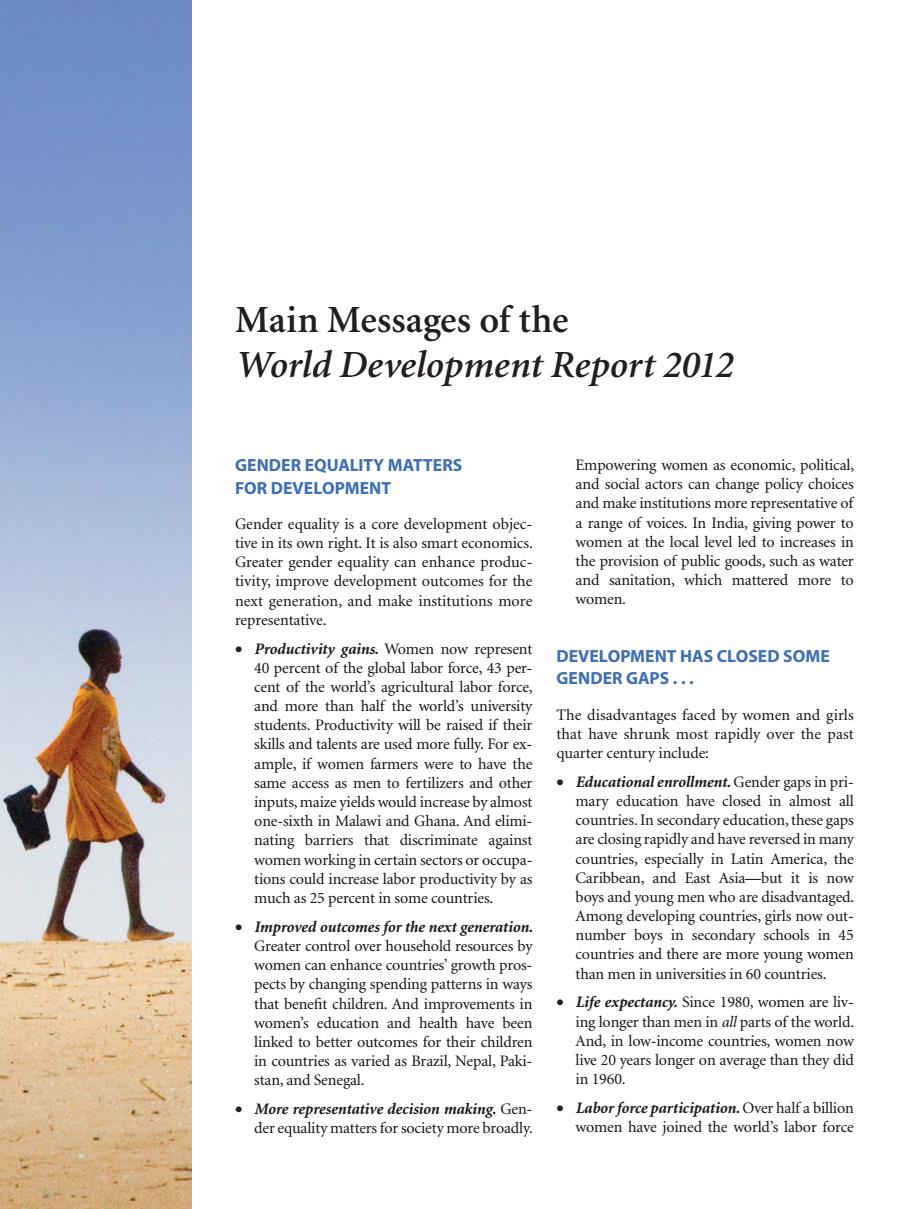正在加载图片...

Main Messages of the World Development Report 2012 GENDER EQUALITY MATTERS Empowering women as economic,political, FOR DEVELOPMENT and social actors can change policy choices and make institutions more representative of Gender equality is a core development objec- a range of voices.In India,giving power to tive in its own right.It is also smart economics. women at the local level led to increases in Greater gender equality can enhance produc- the provision of public goods,such as water tivity,improve development outcomes for the and sanitation,which mattered more to next generation,and make institutions more women. representative. Productivity gains.Women now represent DEVELOPMENT HAS CLOSED SOME 40 percent of the global labor force,43 per- cent of the world's agricultural labor force, GENDER GAPS... and more than half the world's university students.Productivity will be raised if their The disadvantages faced by women and girls skills and talents are used more fully.For ex- that have shrunk most rapidly over the past ample,if women farmers were to have the quarter century include: same access as men to fertilizers and other Educational enrollment.Gender gaps in pri- inputs,maize yields would increase by almost mary education have closed in almost all one-sixth in Malawi and Ghana.And elimi- countries.In secondary education,these gaps nating barriers that discriminate against are closing rapidly and have reversed in many women working in certain sectors or occupa- countries,especially in Latin America,the tions could increase labor productivity by as Caribbean,and East Asia-but it is now much as 25 percent in some countries. boys and young men who are disadvantaged. Among developing countries,girls now out- Improved outcomes for the next generation. Greater control over household resources by number boys in secondary schools in 45 women can enhance countries'growth pros- countries and there are more young women than men in universities in 60 countries. pects by changing spending patterns in ways that benefit children.And improvements in Life expectancy.Since 1980,women are liv- women's education and health have been ing longer than men in all parts of the world. linked to better outcomes for their children And,in low-income countries,women now in countries as varied as Brazil,Nepal,Paki- live 20 years longer on average than they did stan,and Senegal. in1960. More representative decision making.Gen- .Labor force participation.Over half a billion der equality matters for society more broadly. women have joined the world's labor forceGENDER EQUALITY MATTERS FOR DEVELOPMENT Gender equality is a core development objective in its own right. It is also smart economics. Greater gender equality can enhance productivity, improve development outcomes for the next generation, and make institutions more representative. • Productivity gains. Women now represent 40 percent of the global labor force, 43 percent of the world’s agricultural labor force, and more than half the world’s university students. Productivity will be raised if their skills and talents are used more fully. For example, if women farmers were to have the same access as men to fertilizers and other inputs, maize yields would increase by almost one-sixth in Malawi and Ghana. And eliminating barriers that discriminate against women working in certain sectors or occupations could increase labor productivity by as much as 25 percent in some countries. • Improved outcomes for the next generation. Greater control over household resources by women can enhance countries’ growth prospects by changing spending patterns in ways that benefi t children. And improvements in women’s education and health have been linked to better outcomes for their children in countries as varied as Brazil, Nepal, Pakistan, and Senegal. • More representative decision making. Gender equality matters for society more broadly. Empowering women as economic, political, and social actors can change policy choices and make institutions more representative of a range of voices. In India, giving power to women at the local level led to increases in the provision of public goods, such as water and sanitation, which mattered more to women. DEVELOPMENT HAS CLOSED SOME GENDER GAPS . . . The disadvantages faced by women and girls that have shrunk most rapidly over the past quarter century include: • Educational enrollment. Gender gaps in primary education have closed in almost all countries. In secondary education, these gaps are closing rapidly and have reversed in many countries, especially in Latin America, the Caribbean, and East Asia—but it is now boys and young men who are disadvantaged. Among developing countries, girls now outnumber boys in secondary schools in 45 countries and there are more young women than men in universities in 60 countries. • Life expectancy. Since 1980, women are living longer than men in all parts of the world. And, in low-income countries, women now live 20 years longer on average than they did in 1960. • Labor force participation. Over half a billion women have joined the world’s labor force Main Messages of the World Development Report 2012